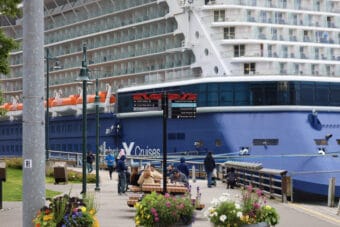
Southeast Alaska, home to the core of Alaska’s tourism industry, has largely recovered from the economic disaster caused by COVID-19, but the region still has fewer jobs than it did before the start of the pandemic.
Complete recovery may happen in 2023, attendees of Southeast Conference, a regional economic and local government conference, were told Tuesday in Ketchikan.
“We’re building back, but we’re not entirely there yet,” said Meilani Schijvens of Rain Coast Data, an economic firm that focuses on Southeast Alaska.
Scott Habberstad, chair of the Alaska Travel Industry Association Board of Directors, was cautiously optimistic.
“There’s a lot of opportunity for complete recovery and growth. But are we at the beginning of a recession and are we going to go into a recession?” he said, referring to the possibility of Federal Reserve interest rate increases.
“If we’re going into a recession, are people going to put their money into their pocket, or are they going to travel?” he said.
Southeast Alaska is heavily reliant on the tourism industry, and tourists who arrive in Southeast Alaska by cruise ship frequently travel to other parts of the state. The summer seasonal tourism industry employs thousands of Alaskans, some of whom rely on summer earnings to support themselves for the rest of the year.
Between 2019 and 2020, the number of tourists coming to Alaska fell by 82%. The number of cruise ship passengers arriving in the state dropped from more than 1.3 million to 48.
Southeast Alaska was among the hardest-hit places in the country by the resulting economic recession, Schjivens said. Businesses had spent millions of dollars preparing for the 2020 tourism season only to see it evaporate.
The regional fishing industry — another economic mainstay — also suffered in 2020 from poor salmon returns and low prices.
As a result, employment in Southeast Alaska dropped by 9,800 jobs — 24% of all jobs in the region — between June 2019 and June 2020.
Federal aid prevented many businesses from permanently closing, Schijvens said.
“The significant federal investments into the region in the form of COVID relief dollars worked as intended. Businesses, workers, and communities were able to continue in a stasis-like existence throughout the economically-impoverished early pandemic period, giving Southeast Alaska an economy to come back to in 2022,” she wrote in Southeast by the Numbers, an annual economic report card for the region.
As of June 2022, employment in Southeast Alaska remains 12% lower — down by 5,200 — than it was in June 2019.
Statewide, employment is down by 6%. For context, national employment was higher in June 2022 than it was in June 2019.
Business owners say conditions are better
Though the region hasn’t fully recovered, surveys conducted by Schijvens found business owners more optimistic about the future than at any point since the COVID-19 pandemic began.
Of 440 surveyed in 2021, 80% said the business climate was “poor” or “very poor,” and that was an improvement from 2020. This year, that proportion has dropped to 36%.
More than three-quarters of the businesses surveyed said they expect conditions to be better next year than this year.
Some of that optimism has been driven by the cruise ship industry’s rebound from COVID-19.
After the 48 passengers recorded in 2020, Southeast Alaska counted 124,600 cruise ship passengers in 2021. This year, Schijvens forecasts about 1 million tourists by cruise ship.
Optimism for 2023 but unknowns remain
Next year, based on the number of sailings and projected interest, she expects about 1.3 million — roughly the same amount that sailed to Alaska in 2019, the last year before the pandemic.
Air travel has also rebounded, with the number of passengers this year running only slightly below what it was in 2019.
“Tourism is back, and it is thriving,” she said.
Habberstad, who also works for Alaska Airlines, is more cautious. He said there’s several unanswered questions when looking ahead to 2023.
During the pandemic, Alaska was a convenient destination for Americans who couldn’t vacation internationally. Will that change? Will economic pressures force people to curtail spending? Will the war in Ukraine, COVID lockdowns in Asia and a strong dollar discourage international visitors from coming to Alaska?
Fall and winter are traditionally the times when tourists book trips for the next season. There’s a lot of opportunity but a lot of uncertainty, Habberstad said.
“I think we’ll have a better idea in December,” he said.



